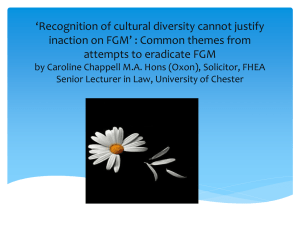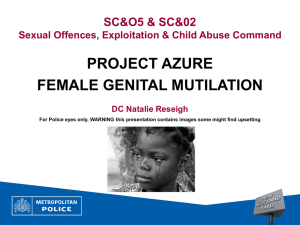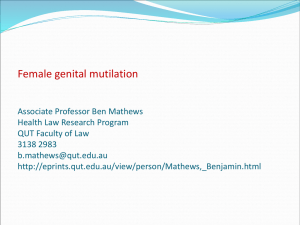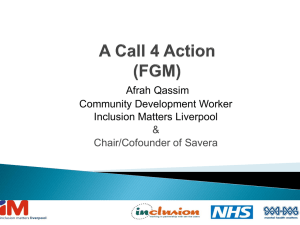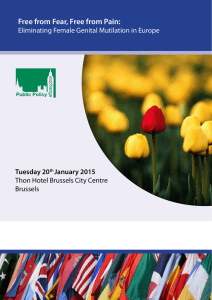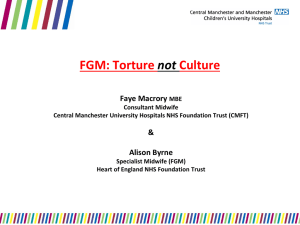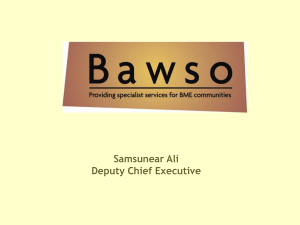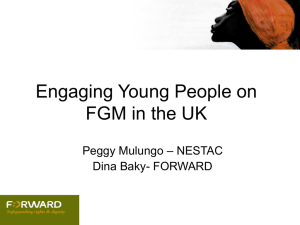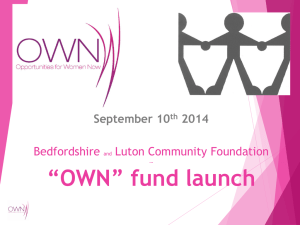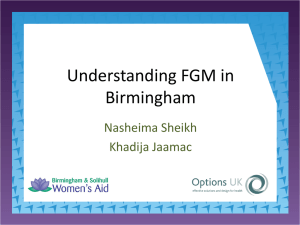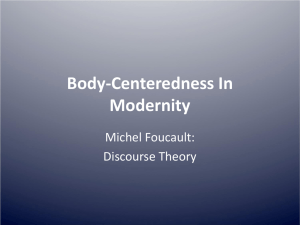Document 5483483
advertisement
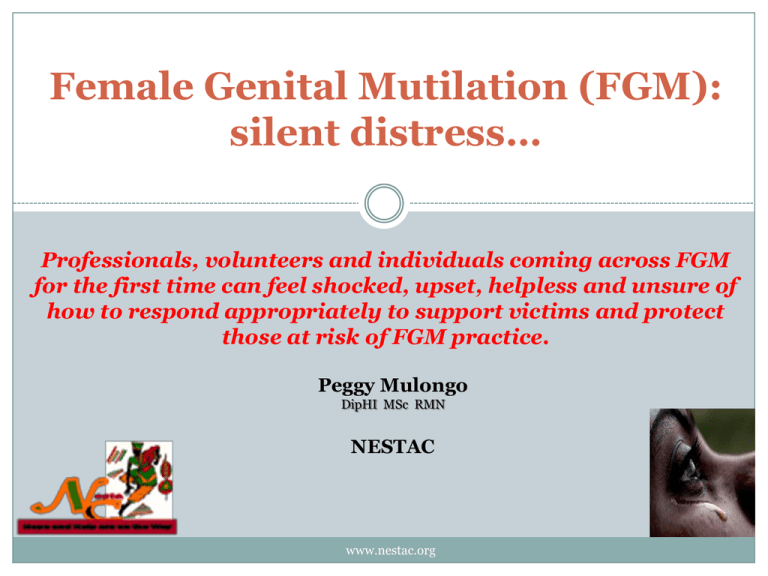
Female Genital Mutilation (FGM): silent distress… Professionals, volunteers and individuals coming across FGM for the first time can feel shocked, upset, helpless and unsure of how to respond appropriately to support victims and protect those at risk of FGM practice. Peggy Mulongo DipHI MSc RMN NESTAC www.nestac.org NESTAC who we are… We represent the “New Step for African Community”, a charitable organisation aimed at supporting refugees, asylum seekers and other immigrants from the new emerging communities, especially from African origin. Our focus: - Educate through Cross-cultural awareness trainings/events - Support, Advocate and Empower clients to fulfil their potential - Research, Inform and Share learning on Cultural issues - Health and wellbeing, using trans-cultural therapeutic approach Our vision: Fully Integrated Active Citizens , sharing good values, and having fair and equality of opportunities. www.nestac.org Our Health and Wellbeing Programme… • FGM PROJECT • CULTURAL COUNSELLING • DROP-IN CLINICS (ROCHDALE, SALFORD, NORTH MANCHESTER) • HEALTH AND WELLBEING ACTIVITIES www.nestac.org What is Female Genital Mutilation? (FGM) The terms “Female Genital Mutilation", "female genital cutting“; female circumcision” and "female genital mutilation/cutting" refer to all procedures involving partial or total removal of the external female genitalia or other injury to the female genital organs for non-medical reasons Adapted from World Health Organization 2008 www.nestac.org Types of FGM Type I (clitoridectomy): Excision of the prepuce, with partial or total removal of the clitoris. Type II (Excision): Excision of the prepuce and clitoris together with partial or total excision of the labia minora. Type III (Infibulation): excision of part or all of the external genitalia and stitching or narrowing of the vaginal opening. 15% of all cases. It involves the use of thorns, silk or catgut to stitch the two sides of the vulva. Type IV : All other harmful procedures including pricking, piercing or incision of the clitoris and/or the labia; stretching of the clitoris and or the labia; cauterisation or burning of the clitoris and surrounding tissues, scraping of the vaginal orifice or cutting (Gishiri cuts) of the vagina and introduction of corrosive substances or herbs into the vagina. source: WHO 2008 www.nestac.org Who is at risk? From shortly after birth to the labour of the first child Pregnant women Babies Children and young girls Adulthood www.nestac.org Who is at risk? 3 million girls undergo FGM every year About 140 million girls and women have already undergone FGM A girl born to a mother who has already undergone FGM between 0-14 years may be at increased risk A girl born to a father who comes from an affected community Immigrant communities in Europe, America and Australia from affected communities www.nestac.org Communities at Risk In some places, FGM as being practised by specific ethnic groups, rather than by a whole country 28 practising countries in Africa Djibouti (98%); Somalia (97%); Sierra Leone (90%); Ethiopia (79.9%); Sudan (90%); Guinea (98.6%); Egypt (97%). Amongst some Bedouin women in Israel Malaysia, Indonesia and Bohra Muslim populations in parts of India and Pakistan The Middle East (Yemen, Oman, Iraqi Kurdistan) Ethiopian Jews In the UK, 6500 girls are at risk of FGM every year (Dorkenoo et al, 2007). www.nestac.org Prevalence of FGM 15-49 yrs 'Below 10 per cent '10 - 40 per cent '41 - 70 per cent 'More than 70 per cent Source: UNICEF- October 2010- global databases based on data from MICS, DHS and other national surveys, 1997-2009. How is FGM carried out? Generally carried out by an elder woman in the community, with non-medical training Non-sterile instruments without anaesthetic are used (razor blade, knife, sharp piece of glass, scissors) Iodine or Mixture of herbs often placed on the wound to stop the bleeding Increased use of health professionals to avoid the health complications www.nestac.org Socio-cultural context of FGM • • • • • • • • CULTURAL AND/OR TRADITION – RELIGION – VIEWED AS RELIGIOUS OBLIGATION MARRIAGE- CONTROL OF SEXUALITYACCESS FAMILY HONOUR INITIATION INTO WOMANHOOD PURITY, CHASTITY, AESTHETICS AND HYGIENE – GENDER IDENTITY www.nestac.org FGM is a social convention Many women believe that FGM is necessary to ensure acceptance by their community; they are unaware that FGM is not practised in most of the world. • FGM THRIVES ON SOCIAL APPROVAL AND CONFORMITY THROUGH STRONG SOCIAL PRESSURE • FAILURE TO CONFORM OFTEN LEADS TO SOCIAL EXCLUSION, OSTRACISM, STIGMA ETC. • FGM IS A RULE OF BEHAVIOUR ENFORCED THROUGH REWARDS, BENEFITS AND SOCIAL SANCTIONS www.nestac.org Health issues Short term effects: Severe pain and shock Urine retention Immediate fatal haemorrhaging Infection Injury to adjacent tissues Long term effects: Difficulty conceiving –Infertility Keloid formation and Chronic pain Painful cramps during menstruation Cysts and neuromas Difficulty passing urine, recurrent UTIs Psychological damage Increased risk of Vesico Vaginal Fistula Uterus, vaginal and chronic pelvic infections Complications in pregnancy and child birth Bleeding (due to repeated de-infibulations / infections) Sexual dysfunction / genital phobia/ painful sexual intercourse. www.nestac.org Emotional consequences 14 Research have proven that negative mental health consequences are related to: • severe forms of FGM, immediate post-FGM complications, chronic health problems and/or loss of fertility secondary to FGM, non-consensual circumcision in adolescence or adulthood. Resulting to: • psychological and psychosomatic disorders including Post Traumatic Stress Disorder (PTSD), anxiety, depression, and memory loss. OUR DROP-IN CLINICS... Trans-cultural Therapy 15 • Women are offered a culturally adapted therapy to address FGM issues affecting their emotional wellbeing • Tailored cultural counselling sessions are offered and arranged for sufferers and those at risk, in strict confidentiality • Boyfriends / partners are referred for cultural counselling they are usually supportive when the reality is explained to them • Peer mentors training is offered to people from practicing communities to help support their peers emotionally Our Clients… 16 • Women receiving psychosocial therapy in our clinics report feelings of betrayal by parents, incompleteness, regret and anger. • Women describe how FGM is an extremely traumatic experience, the long-lasting emotional damage this causes in their lives, and how hard it is to suffer in silence. • “It is all about values, culture and traditions” they say. • They hope that as they become more informed about health consequences and cross the threshold from traditional Africa to the modern society, their silence will give place to a strident scream against FGM. Interacting with Health Services in UK Many feel shy, ashamed and lose their confidence when examined “We feel different from other women & wonder what doctors think of us” “Because of FGM many women have difficulty to visit their doctors” “It is embarrassing especially when we are asked why we did this to ourselves, we don’t have an answer” www.nestac.org FGM Law & Child Protection Female Genital Mutilation Act 2003 Makes it a criminal offence to: • Excise, infibulate or otherwise mutilate the whole or any part of a girl or woman’s labia majora, labia minora or clitoris. • Aid, abet, counsel or procure a girl to mutilate her own genitalia; or • Aid, abet, counsel or procure a nonUK person to mutilate a UK national’s or permanent resident’s genitalia outside of the UK. www.nestac.org The context of FGM in Greater Manchester Greater Manchester FGM Forum • FGM prevalence document in Greater Manchester • FGM leaflet to be distributed across Greater Manchester • FGM e-learning package: http://www.endthefear.co.uk/media/uploads/fgm/story.html www.nestac.org CONTACT US IF YOU NEED FURTHER INFORMATION PLEASE CONTACT US THROUGH: E-MAIL: TEL: WEB: INFO@NESTAC.ORG 01706 868993 WWW.NESTAC.ORG THANK YOU ALL!!!!! www.nestac.org
